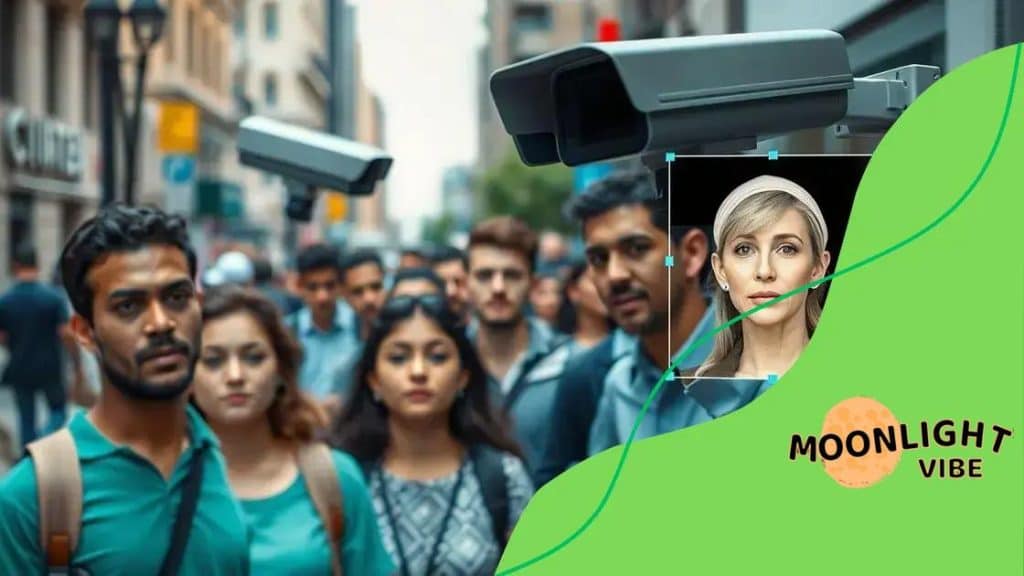The role of facial recognition in enhancing public safety

Anúncios
The role of facial recognition in enhancing public safety involves quickly identifying suspects, preventing crime, and improving law enforcement efficiency while addressing privacy concerns and ethical considerations.
The role of facial recognition in enhancing public safety has become a hot topic lately. How do these technologies actually impact our daily lives and safety? Let’s dive in to discover the truth behind the headlines.
Anúncios
Understanding facial recognition technology
Understanding facial recognition technology is essential as it plays a significant role in today’s safety measures. This technology uses algorithms to identify and verify individuals based on their facial features.
Facial recognition systems analyze facial images captured by cameras and compare them to databases of known faces. These systems can detect unique characteristics, such as the distance between eyes and the shape of the jaw.
How it works
There are several steps involved in the facial recognition process:
Anúncios
- Image capture: Cameras capture images or videos of faces in various lighting and angles.
- Face detection: The system identifies and locates a face in the image.
- Feature extraction: Key facial features are extracted and converted into numerical representations.
- Face matching: The extracted features are compared with those in a database to find a match.
This process occurs rapidly, enabling facial recognition technology to operate efficiently in real-time scenarios. The advancement of artificial intelligence has significantly improved the accuracy of these systems.
Applications in public safety
Facial recognition is utilized in various fields for enhancing security. Some notable applications include:
- Law enforcement: Police use this technology to track down suspects and solve crimes.
- Airports: Many airports employ facial recognition for passenger identification to expedite security checks.
- Public events: Security personnel at large events use it to monitor crowds for potential threats.
As the technology continues to evolve, it shows potential for even wider use in public safety initiatives. However, it raises important questions about privacy and ethical considerations. Balancing the benefits of enhanced security with the rights of individuals is critical as society navigates this complex issue.
How facial recognition enhances crime prevention
How facial recognition enhances crime prevention is a vital topic in the field of public safety. This technology allows law enforcement agencies to identify and apprehend criminals more efficiently.
One of the primary ways that facial recognition contributes to crime prevention is through real-time surveillance. Cameras installed in public spaces can analyze faces instantly, enabling police to act quickly when they detect suspicious behavior. The ability to match faces against databases of known offenders significantly speeds up the investigative process.
Benefits of facial recognition technology in policing
Facial recognition systems offer several advantages that improve crime prevention strategies:
- Quick identification: Law enforcement can identify suspects immediately, which helps in apprehending them before they commit further crimes.
- Reduced manpower: Automated systems decrease the need for large numbers of officers monitoring live feeds, allowing them to focus on other essential tasks.
- Increased accuracy: Modern algorithms provide high levels of accuracy, minimizing the chances of false positives.
- Deter criminal activity: The knowledge that facial recognition is in use can discourage individuals from engaging in illegal acts.
Another important aspect is that facial recognition technology can aid in solving past crimes. By examining footage from prior incidents, police can identify suspects who may not have been recognized initially. This capability ensures that investigations remain active, even after initial leads have faded.
Moreover, this technology can also enhance community-police relationships. As communities see effective crime prevention measures in action, trust and cooperation with law enforcement can improve. When citizens feel safer, they are more likely to engage with police positively.
Privacy concerns surrounding facial recognition

Privacy concerns surrounding facial recognition have become increasingly important as this technology expands in use. While facial recognition can enhance public safety, it also raises significant questions about individual rights and personal privacy.
Many people worry that being constantly monitored by cameras could infringe on their freedoms. The idea that faceless algorithms are tracking movements and storing personal data can be unsettling. For many, this means a loss of anonymity in public spaces.
Key privacy issues
Several key issues arise from the widespread use of facial recognition technology:
- Data security: The collection и storage of facial images require robust security measures to prevent data breaches.
- Misuse of data: Without clear regulations, stored data could be manipulated or used for purposes other than crime prevention.
- Bias and accuracy: Facial recognition systems have faced criticism for inaccuracies, particularly with regard to different demographics. This could lead to unfair targeting of certain groups.
- Lack of consent: Many users do not realize when their faces are being scanned, raising ethical concerns about consent and individual rights.
Moreover, legal frameworks regarding facial recognition differ widely. Some countries strictly regulate its use to protect citizens, while others adopt a more lax approach. The lack of universal standards creates confusion about what is acceptable.
As public discourse around these issues continues, technology companies and law enforcement must strive for transparency. Engaging the community in discussions about the implications of facial recognition can help balance safety and privacy.
Real-world applications of facial recognition
Real-world applications of facial recognition technology have grown significantly in recent years. This technology is not just limited to security; it has various practical uses across different industries.
One of the most common applications is in law enforcement. Police departments utilize facial recognition to identify suspects quickly. By analyzing surveillance footage, they can match faces to a database of known offenders. This can lead to faster arrests and improved public safety.
Applications in different sectors
Facial recognition is employed in several fields beyond policing:
- Retail: Many stores use facial recognition for customer identification. This helps them tailor marketing strategies and improve customer service.
- Healthcare: Hospitals use this technology to ensure accurate patient identification, which helps in preventing medical errors.
- Banking: Financial institutions implement facial recognition for secure transactions, allowing customers to access accounts using just their faces.
- Travel: Airports increasingly adopt facial recognition at check-in and boarding to streamline processes and enhance security.
In education, schools have started using facial recognition to monitor student attendance. This automation makes the administrative process more efficient, allowing teachers to focus on teaching rather than taking roll calls.
However, as these applications expand, it’s essential to maintain ethical standards. The balance between safety, convenience, and privacy remains a critical conversation in society today. Engaging with communities to address concerns can lead to a more responsible application of facial recognition technology.
The future of facial recognition in public safety
The future of facial recognition in public safety holds significant promise as technology continues to evolve. As we look ahead, the incorporation of advanced algorithms and artificial intelligence will enhance the accuracy and efficiency of these systems.
One key aspect of the future is the integration of facial recognition with other technologies, such as artificial intelligence and machine learning. These advancements will allow for more sophisticated analyses while minimizing bias and improving results across different demographics.
Potential advancements
Several potential advancements could shape how facial recognition is utilized in public safety:
- Enhanced accuracy: Future systems will likely feature improved algorithms that reduce errors in identification.
- Real-time processing: With faster computing power, real-time analysis of facial recognition data will become commonplace, helping to prevent crimes as they occur.
- Improved data security: As privacy concerns grow, solutions that protect personal information while using facial recognition will be essential.
- Broader applications: Beyond law enforcement, public safety applications may extend to emergency response, disaster management, and community safety efforts.
Furthermore, public engagement will be critical in shaping these technologies. Communities must be involved in discussions about how facial recognition is used, ensuring that ethical considerations are addressed. Transparency and accountability will help build trust between the technology and the people it serves.
As we look toward the future, a collaborative approach between technology developers, law enforcement, and the public will be essential in creating a balanced and effective use of facial recognition for safety.
In conclusion, facial recognition technology plays a crucial role in the future of public safety. As it becomes more advanced, its ability to identify and prevent crime will improve. However, it is essential to balance the benefits of safety with privacy concerns. Community engagement and ethical considerations must be part of the conversation. By working together, we can ensure that facial recognition technology is used responsibly for the greater good.
FAQ – Frequently Asked Questions about Facial Recognition in Public Safety
How does facial recognition technology enhance public safety?
Facial recognition technology helps quickly identify suspects, thereby preventing crime and improving law enforcement efficiency through faster arrests.
What are the privacy concerns associated with facial recognition?
Privacy concerns include the potential for constant surveillance, data security risks, and the lack of consent from individuals being monitored.
What advancements are expected in facial recognition technology?
Future advancements may include enhanced accuracy, real-time processing, improved data security, and broader application in various sectors.
How can communities engage with facial recognition technology discussions?
Communities can engage in discussions by participating in public forums, providing feedback to local authorities, and advocating for ethical standards in technology use.





